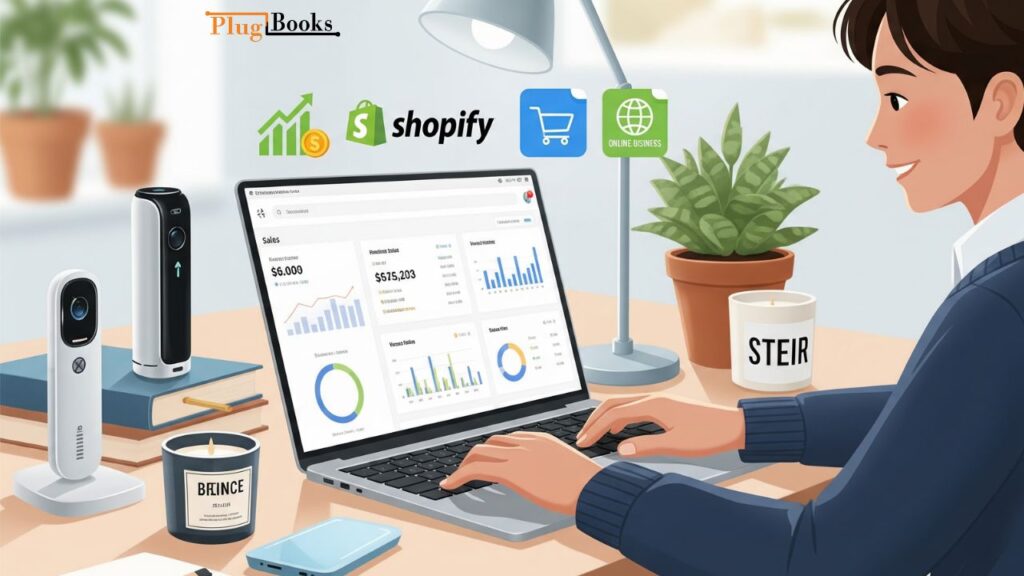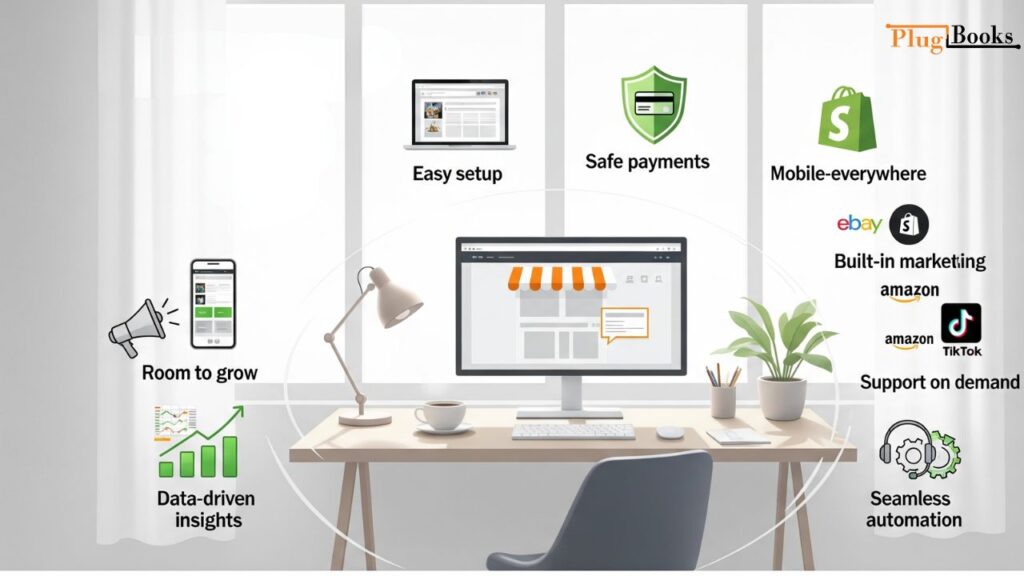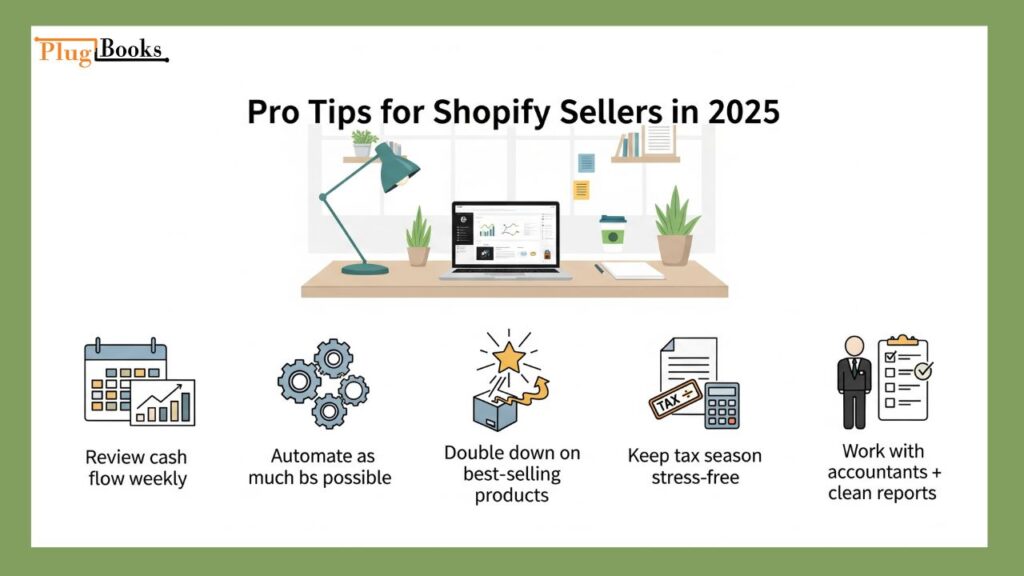If you’ve ever thought about starting an online business, chances are you’ve heard of Shopify. Becoming a Shopify seller in 2025 is easier than ever, and it’s one of the smartest moves for entrepreneurs who want to reach a global audience.
But here’s the truth: creating an account and adding products is only the first step. To really succeed, you’ll need financial clarity, smooth bookkeeping, and a system that saves you from drowning in spreadsheets. That’s where PlugBooks comes in.
In this guide, we’ll chat about:
- What it means to be a Shopify seller in today’s market
- Step-by-step tips on how to create shopify seller account
- Why many sellers rely on shopify seller accountants
- The biggest benefits of selling on Shopify
- And of course, how PlugBooks can take the stress out of bookkeeping
Who Exactly is a Shopify Seller?
A Shopify seller is simply someone who uses Shopify to sell products online. It doesn’t matter whether you’re running a small handmade shop or managing a large inventory of electronics—you’re part of a huge community of sellers building their businesses on Shopify.
The beauty of Shopify is flexibility. You can sell from your own website, connect your store to Amazon and eBay, or even sell directly on social media platforms like Instagram. With the right tools in place, scaling your business is much less intimidating.

How to Create a Shopify Seller Account (Step by Step)
Let’s break it down. Many new entrepreneurs ask us: how to create shopify seller account? Here’s the quick roadmap:
- Head over to Shopify’s website and click Start Free Trial.
- Enter your email, business details, and pick a store name.
- Complete your shopify seller account setup by choosing payment options, adding tax info, and adjusting shipping settings.
- Upload products, customize your theme, and hit publish.
And that’s it—you’re alive! 🎉
Pro tip: Don’t wait until tax season to worry about bookkeeping. With PlugBooks Auto Send Settlements, you can automatically sync your Shopify store with QuickBooks or Xero from day one, keeping your finances organized and stress-free.
Why Sellers Love Shopify: Benefits That Matter
The real question isn’t why sell on Shopify—it’s why not? Here are some of the biggest perks of being a Shopify seller in 2025:
- Super easy setup → You don’t need to be a techie to launch a professional store.
- Safe and secure payments → Accept global payments with Shopify Payments, PayPal, or Stripe.
- Sell everywhere → From Shopify to Amazon, eBay, and even TikTok.
- Mobile-first design → Your store will look great on any device.
- Built-in marketing tools → SEO, discounts, abandoned cart recovery—it’s all there.
- Room to grow → Start small or scale big, Shopify grows with you.
- Support on demand → Shopify’s 24/7 support has your back.
- Data-driven insights → Analytics help you make smarter decisions.
- Seamless automation → With PlugBooks, your reports and taxes are handled automatically.

Do You Really Need Shopify Seller Accountants?
Here’s the thing: once your store picks up, keeping track of sales, expenses, and taxes can get messy. Many sellers turn to Shopify seller accountants for help—and they play an important role in keeping your finances compliant.
But let’s be honest—hiring full-time accountants is expensive. That’s why many sellers choose PlugBooks instead. It’s like having a digital accountant that never sleeps. Your Shopify, Amazon, and eBay data flow straight into QuickBooks or Xero, no manual entry needed.
The Not-So-Glamorous Side of Selling on Shopify
Running a store isn’t always smooth sailing. Even the most seasoned Shopify seller deals with challenges like:
- Reconciling refunds and payouts
- Keeping track of transaction fees
- Monitoring cash flow across multiple platforms
- Staying tax-ready without pulling all-nighters
And that’s exactly where automation can save the day. Instead of juggling spreadsheets, PlugBooks keeps your numbers consistent and accurate—all in real time.
How PlugBooks Makes Shopify Selling Stress-Free
So what makes PlugBooks a must-have for every Shopify seller?
- Automatic syncing → Orders, refunds, and payouts update instantly.
- Multi-channel integration → Combine data from Shopify, Amazon, and eBay.
- Clean bookkeeping → Say goodbye to costly mistakes.
- Always tax-ready → Reports you can trust during tax season.
- Time back in your day → Focus on customers and growth, not data entry.
If you’ve been juggling multiple apps or chasing accountants, this is your shortcut to clarity. Plus, check out how to analyze sales channel profits using PlugBooks to get even deeper insights into your business performance.

Pro Tips for Shopify Sellers in 2025
Want to stay ahead? Here are a few tried-and-true tips every shopify seller should keep in mind:
- Review your cash flow weekly.
- Automate as much as possible (PlugBooks is a game-changer here).
- Double down on your best-selling products.
- Keep tax season stress-free by syncing early, not late.
- If you work with shopify seller accountants, use PlugBooks to give them clean, error-free reports.

FAQs
Q1. How do I create a Shopify seller account?
It’s simple. Just sign up on Shopify, enter your details, and follow the guided setup. If you’re still wondering how to create a shopify seller account, Shopify walks you through the whole process.
Q2. Do I really need accountants for my Shopify seller account?
Many sellers work with shopify seller accountants for taxes and reporting. But with PlugBooks, you can automate most of it without the high cost.
Q3. What’s the biggest benefit of being a Shopify seller?
Flexibility. You can start small, sell across multiple channels, and automate your finances with tools like PlugBooks.
Q4. How exactly does PlugBooks help Shopify sellers?
PlugBooks connects your Shopify data with QuickBooks or Xero, automatically recording orders, refunds, and payouts—error-free and tax-ready.
Q5. Can I manage multiple stores under one Shopify seller account?
Yes, and PlugBooks makes it even easier by consolidating all your data in one clean dashboard.

Final Thought
And with tools like PlugBooks, you can automate bookkeeping, reduce errors, and focus on what really matters—growing your sales and delighting your customers.
Becoming a Shopify seller in 2025 is more than just opening an online store—it’s about building a business that runs smoothly, stays financially healthy, and scales with confidence. From setting up your Shopify seller account to working with Shopify seller accountants, every step counts toward long-term success.



